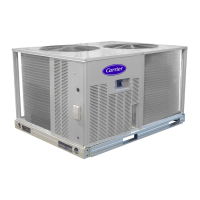INDOOR
COIL CKT 2
AIRFLOW
INDOOR
COIL CKT 1
AIRFLOW
TXV
SENSING
BULB
EQUALIZER LINE
S_GHTGLASS
LOCATION
HLTER DRIER
LOCATION
LEGEND
TXV -- Thermostatic Expansion Valve
C11037
Fig. 6 - Location of Sight Glass(es) and Filter Driers
(typical 38AUQ size 12)
Table 6 - Minimum Outdoor Air Operating Temperature
UNIT
38AUQ07
38AUQ08
38AU Q 12
%
COMPRESSOR
CAPACITY
1O0
MINIMUM OUTDOOR
TEMP -- F (C)*
Head Pressure
Standard Unit Controlt
35 (1.7) -20 (-28.9)
35 (1.7) -20 (-28.9)
35 (1.7) -20 (-28.9)
Applies to Cooling mode of operation only.
Wind baffles (field-supplied and field-installed) are recommended for all
units with low ambient head pressure control. Refer to Low Ambient
Control Installation Instructions (shipped with accessory) for details.
Table 7 - Insulation for Vapor Line Exposed
to Outdoor Conditions
LENGTH OF EXPOSED
INSULATION THICKNESSt
VAPOR LINE*
ft m in. mm
10 3 3/8 10
25 8 1/2 18
35 11 3/4 19
50 15 3/4 19
Recommended vapor line insulation for piping exposed to outdoor
conditions to prevent loss of heating during heating cycle. When vapor
line goes through interior spaces, insulation should be selected to pre-
vent condensation on cooling cycle. Heating capacity should be re-
duced 1000 Btuh (295 W) if over 35 ft (11 m) of vapor line with 3/4 in. (19
mm) insulation is exposed to outdoor conditions.
Closed cell foam insulation with a thermal conductivity of: 0.28 Btu °
in./ft 2 • h • °F (0.04 W/m • °C).
Make Piping Connections i
Piping connections at the 38AUQ unit are ball valves with
stub tube extensions. Do not open the unit service valves
until all interconnecting tube brazing as been completed.
The stub tube connections include 1/4-in SAE service fittings
with Schrader valve cores (see Fig. 7). Before making any
brazed connections to the unit service valves, remove both
Schrader valve caps and cores and save for re-installation.
Connect a source for nitrogen to one of these service fittings
during tube brazing to prevent the formation of copper
oxides inside the tubes at brazed joints.
Factory
High-Flow
Access Port
Field Service
Port
(Schrader core)
ServiceValve
with Stem Cap _Sweat
Connection
C10203
Fig. 7 - Typical Piping Connection Assembly
When connecting the field tubing to the 38AUQ service
valves, wrap the valves in wet rags to prevent overheating
Pressure-test all joints from outdoor unit connections over
to the indoor coil, using nitrogen as pressure and with
soap-and-bubbles.
When pressure-testing is completed, remove the nitrogen
source at the outdoor unit service valves and re-install the
two Schrader valve cores. Torque the cores to 2-3 in-lbs
(23-34 N-cm).
Where vapor line is exposed to outdoor air, line must be
insulated. See Table 7 for insulation requirements.
Evacuation/Dehydration I
Evacuate and dehydrate the connected refrigeration
system(s) (excluding the 38AUQ unit) to 500 microns
using a two-stage vacuum pump attached to the service
ports outside the 38AUQ service valves, following
description in GTAC II, Module 4, System Dehydration.
UNIT OPERATION AND SAFETY HAZARD
Failure to follow this warning could cause personal
injury, death and/or equipment damage.
Puron <n>(R-410A) refrigerant systems operate at
higher pressures than standard R-22 systems. Do not
use R-22 service equipment or components on Puron
refrigerant equipment.
I IMPORTANT: Charge in Cooling mode only! I
Preliminary Charge --
Before starting the unit, charge R-410A liquid refrigerant
into the high side of each 38AUQ circuit through the
liquid service valve(s). The amount of refrigerant added
must be at least 80% of the operating charge listed in
Table 2 for LINEAR line length LESS the factory charge
quantity (if factory shipping charge has not been
removed). See the following example.
Allow high and low side pressures to equalize. If pressures
do not equalize readily, charge R-410A vapor (using
special service manifold with expansion device) into the
vapor line service port for the low side of system to assure
11

